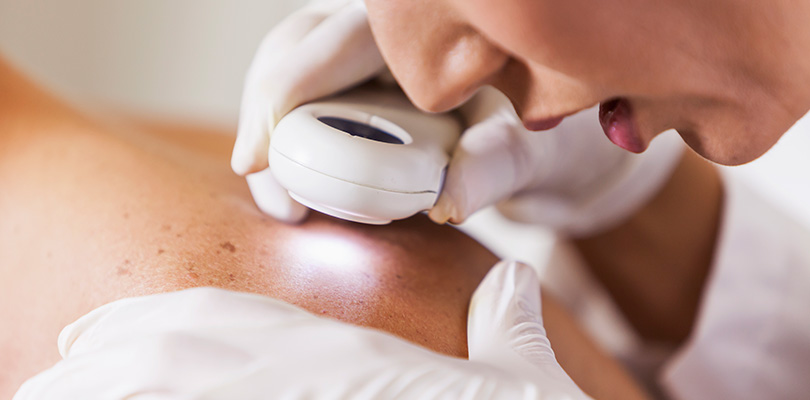Types of Skin Cancer You Need to Be Aware Of
More than three million cases of skin cancer are diagnosed every year. With such a tremendous number of people getting skin cancer, you need to equip yourself with some information about the different types of skin cancer that are out there.
Your skin is constantly changing. It has many layers; one layer is made up of round basal cells below the skin surface (in the lowest part of the epidermis). These cells flatten out as they steadily rise upward to eventually replace the dead, flaking squamous cells on the skin’s surface. The sensation of touch comes from your Merkel skin cells. You also have melanocytes which tan your skin in the sunlight. When damage occurs to any of these skin cells, it may develop into skin cancer.
All of these skin cells can be infected with cancer, causing an abnormal growth of the cells that rapidly multiply to form malignant tumors. The biggest culprit of causing skin cancer is sun exposure, and it can lead to a number of different diagnoses.
The three main types of skin cancer are melanomas, basal cell carcinomas, and squamous cell carcinomas. Below is an overview of these common types of skin cancer (and a few less common varieties for good measure):
Melanoma
Melanoma is a type of cancer most people have heard about. It is the fifth most common cancer in the United States and nineteenth most common cancer in the world. Melanoma accounts for about 2 percent of all skin cancer cases.
It is the rarest and deadliest form of skin cancer and is more likely than other cancers to move to the lymph nodes or metastasize (spread) to other parts of the body.
Melanoma comes from the uncontrolled growth of melanocytes which are the skin cells, known as melanin, which produce the brown pigment often referred to as a tan. When melanocytes are exposed to the sun, the cells darken in response to protect deeper layers of skin from the harmful effects of ultraviolet (UV) radiation and results in dark spots or moles on the skin.
Melanoma may also develop in parts of the body not usually exposed to sunlight such as the bottoms of the feet, or the eyes.
The Alphabet Check
The ABCDE method will help you spot potential melanoma.
- Asymmetry: melanoma lesions can be asymmetric where most healthy moles are symmetrical
- Border: the edges of the mole can tell you a lot. Normal moles have sharp, regular borders, and melanoma edges will be irregular and poorly defined.
- Colour: melanomas are generally multicolored in hues of brown, black, red, and even blue. Healthy moles will generally be one color or two, at most.
- Diameter: more prominent moles are more cause for concern. If your mole is larger than 6 millimeters in diameter, get a medical professional to assess it.
- Evolving: moles that change are cause for concern. If the size, shape, color, edges, or texture transform, go and have it looked at.
Basal Cell Carcinoma
Basal Cell Carcinoma is the most common type of skin cancer and one of the most common cancers worldwide. About 80 percent of skin cancers are basal cell carcinoma according to the American Cancer Society.
Basal cell carcinoma is found in areas of the skin that receive the most sun exposure and development in the basal cell layer of the skin over years of frequent sun exposure or indoor tanning. This cancer is easy to overlook because of the incorrect assumption that the tumor is a long-lasting blemish.
The lesions from this type of cancer are shiny bumps or spots that typically occur on the face, neck, and ears. These lesions bleed easily and grow over time and may eventually form scabs or sores that are scaly or flaky.
These cancers are usually very treatable. It is rare for basal cell carcinoma to spread or metastasize to other parts of the body, but it can occur if this cancer is left untreated.
If you’ve had this type of cancer once, you have an increased chance to develop new basal cell cancer in another area; however, it may also recur in the same location that the original cancer formed. Up to 50 percent of those diagnosed with basal cell carcinoma develop a new basal cell carcinoma within five years of their initial diagnosis.
Squamous Cell Carcinoma
The second most common type of skin cancer is squamous cell carcinoma. This cancer accounts for about 20 percent of non-melanoma skin cancers.
Squamous cell carcinoma develops from flat squamous cells that make up the outermost layer of the skin. It is similar to basal cell carcinoma because it appears as a pink or red patch that won’t disappear.
These patches grow larger and become nodular over time, but they grow slowly so you may not notice the cancer for a while. The patches can present as a wart-like surface that can be scaly, itchy, painful, and may bleed. These lesions are not shiny, like basal cell carcinoma. Squamous cell carcinoma may develop in unexpected areas such as scars, skin ulcers, or the genital region.
This cancer is more likely than basal cell carcinomas to affect fatty tissue beneath the skin, but it is relatively uncommon for this cancer to spread or metastasize to other parts of the body. Squamous cell carcinoma is easy to treat when spotted early.
Actinic Keratosis
Actinic keratosis is a precancerous growth or premalignant lesion caused by sun damage or sun exposure. Those affected by actinic keratosis usually have fair skin.
The lesions are usually rough, red (sometimes pink or flesh tone), scaly, and they vary in size. The patches can be both itchy and painful. Some of the lesions develop into squamous cell skin cancers.
These growths may be found in clusters on skin that has been damaged by exposure to UV radiation. You’ll find them on your hands, arms, forearms, face, lips, ears, and any other areas exposed to the sun.
When pancreatic cancer spreads to other parts of the body, it is referred to as metastatic pancreatic cancer, or Stage IV. Read on to learn more.
Merkel Cell Carcinoma
Merkel cell carcinoma is a rare but aggressive form of skin cancer that occupies these cells. It is one of the most dangerous skin cancers because it can grow quickly and rapidly spread to other body parts, including the brain bones, liver, or lungs.
The affected areas are small, painless, and red, purple, or pink in color. This cancer forms nodules on or just under the skin surface that feel firm to the touch and may be shiny.
Merkel cell carcinoma is more common in areas prone to sun exposure and typically develops on the face, neck, and arms but can show up anywhere. People over 50 with a compromised immune system are more at risk for Merkel cell carcinomas.
Kaposi Sarcoma
Another one of the rarer types of skin cancer, Kaposi sarcoma is caused by human herpesvirus 8. Kaposi Sarcoma cancers develop in the cells that line the lymph or blood vessels.
With this type of cancer, there will be the presence of purple, red, or brown lesions or tumors on the skin. Tumors may also form in the mouth, lungs, lymph nodes or along the digestive tract, which is when Kaposi sarcoma becomes a very serious problem.
Many cases of Kaposi sarcoma involve people who are infected with HIV, but this cancer may also occur in patients whose immune system is severely compromised.
Cutaneous Lymphoma
Cutaneous Lymphoma is a type of non-Hodgkin lymphoma of the skin. It, too, is a rare type of skin cancer. This cancer appears as a rash or bumps on the skin. Lymphomas typically develop in the lymph nodes, but they can also develop in other lymphoid tissue including the spleen, bone marrow, and skin.
Risk Factors of Skin Cancer
Anyone can get skin cancer, however, certain factors may increase your chances of getting it. These factors include:
- Fair skin. Less melanin in your skin means you have less protection from UV radiation. Natural blonds or redheads, those with light-colored eyes, and freckles make you a bigger candidate for skin cancer. Those who have a history of sunburns also have an increased skin cancer risk (especially if you’ve had sunburns in adulthood).
- Considerable sun exposure. If you like to work on your tan, you might not be doing yourself any favors, especially if you’re not protected by sunscreen, clothing, or a hat. The extra UV rays make you more prone to skin cancer.
- Moles. Moles, especially irregular or large moles, are more likely to become cancerous down the road. If you have abnormal moles, be sure to check them regularly to make sure they haven’t changed.
- Sunny climates. You may live in a sunny paradise, but it means you’re exposing yourself to more sunlight than folks who live in cooler climates. Make sure you cover up to avoid putting yourself at additional risk.
- Weakened immune systems. People with weakened immune systems, including those with HIV/AIDS or those with organ transplants, should be aware of their increased risk of skin cancer.
- History of skin cancer. If your parents or siblings have had skin cancer, it should serve as a warning that you should be extra cautious. Additionally, if you have a personal history with skin cancer, you may be at risk to get it again.
How Is Skin Cancer Treated?
As skin cancers are all different, there is no universal treatment for all of them. Effective treatments also depend on the size of the tumor, type of cancer, location, depth of the tumor, as well as the general health of the patient.
Here are some of the skin cancer treatments currently available:
- Mohs Surgery: This treatment is used for many squamous cell carcinomas, basal cell carcinomas, and some melanomas. Cancer cells that are detected early can be removed from the skin with minimal impact. The doctor will remove a thin layer of tissue, test to see if any cancer cells remain, then remove another thin layer if there are still cancer cells. The process continues until all the cancer cells have been removed. This method spares as much healthy tissue as possible.
- Excisional Surgery: This surgery is also used for squamous cell carcinomas, basal cell carcinomas, and melanomas. The longer a tumor grows, the deeper it grows into the skin, and the more dangerous it becomes. Rather than the multiple stages of Mohs surgery, excisional surgery has a physician remove the entire tumor with a small safety margin of normal skin removed as well to ensure all of the cancer is cut out. The tumor is then sent for testing to verify all the cancer cells have been removed.
- Cryosurgery: This surgery addresses superficial squamous cell carcinomas. The doctor freezes and destroys tumor tissue with liquid nitrogen. After a few weeks, the lesion falls off, with no cutting, bleeding, or anesthesia required. There may be additional sessions to ensure all of the cancer cells have been destroyed.
- Curettage and Electrosurgery: This type of treatment is meant for small lesions, but not meant for aggressive or invasive carcinomas. The physician scrapes off the lesion with a sharp curette, then burns the site, essentially cauterizing the area to kill off the cancer cells and stop the bleeding. The process is repeated until all of the tumor cells have been removed.
- Radiation Therapy: Radiation is used primarily for tumors that are hard to treat surgically or for patients that are not suited for surgery (for example, the elderly or those who are not in good health).
The Importance of Self Check-ups for Skin Cancer Prevention
The Skin Cancer Foundations recommends you do a self-check for skin cancer every month. Get a mirror, or buddy up to make sure you check all over your body. If you see a spot on your skin that wasn’t there before, doesn’t look like anything else, is growing, or acting differently than your other moles, schedule an appointment with your doctor.
It’s always better to prevent skin cancer than be given a diagnosis. When you are out in the sun, be sure to cover up, use sunscreen, and take precautions to avoid exposure. Your skin will thank you.







